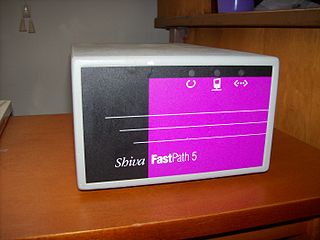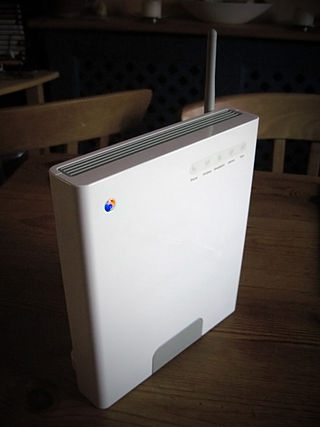Related Research Articles
AppleTalk is a discontinued proprietary suite of networking protocols developed by Apple Computer for their Macintosh computers. AppleTalk includes a number of features that allow local area networks to be connected with no prior setup or the need for a centralized router or server of any sort. Connected AppleTalk-equipped systems automatically assign addresses, update the distributed namespace, and configure any required inter-networking routing.

3Com Corporation was an American digital electronics manufacturer best known for its computer network products. The company was co-founded in 1979 by Robert Metcalfe, Howard Charney and others. Bill Krause joined as President in 1981. Metcalfe explained the name 3Com was a contraction of "Computer Communication Compatibility", with its focus on Ethernet technology that he had co-invented, which enabled the networking of computers.

LocalTalk is a particular implementation of the physical layer of the AppleTalk networking system from Apple Computer.

Apple Attachment Unit Interface (AAUI) is a mechanical re-design by Apple of the standard Attachment Unit Interface (AUI) used to connect computer equipment to Ethernet. The AUI was popular in the era before the dominance of 10BASE-T networking that started in the early 1990s; the AAUI was an attempt to make the connector much smaller and more user friendly, though the proprietary nature of the interface was also criticized.

The Acorn Network Computer was a network computer designed and manufactured by Acorn Computers Ltd. It was the implementation of the Network Computer Reference Profile that Oracle Corporation commissioned Acorn to specify for network computers. Sophie Wilson of Acorn led the effort. It was launched in August 1996.

PhoneNET was an implementation of the AppleTalk networking physical layer created by Farallon Computing(now Netopia).

The PowerBook 500 series is a range of Apple Macintosh PowerBook portable computers first introduced by Apple Computer with the 540c model on May 16, 1994. It was the first to have stereo speakers, a trackpad, and Ethernet networking built-in.
Timbuktu is a discontinued remote control software product originally developed by WOS Data Systems. Remote control software allows a user to control another computer across the local network or the Internet, viewing its screen and using its keyboard and mouse as though sitting in front of it. Timbuktu is compatible with computers running both Mac OS X and Windows.

SpeedTouch is the brand name of a line of networking equipment produced by Alcatel and Technicolor SA. Before 27 January 2010 Technicolor was known as Thomson SA.

The Kinetics FastPath was a LocalTalk-to-Ethernet bridge created in 1985 to allow Apple Macintosh computers to communicate with other computers on Ethernet networks. The product had five significant revisions during its lifetime and was ultimately sold to Shiva Networks late in its existence. The original FastPath was developed to extend AppleTalk on Ethernet for Apple Computer, but from the beginning it was also modeled after an implementation of the Stanford Ethernet–AppleTalk Gateway (SEAGATE) created at Stanford University Medical Center by Bill Croft in 1984 and 1985. SEAGATE was a combination of hardware and software that picked up IP packets from the Ethernet network and encapsulated them inside of DDP packets on the AppleTalk network and conversely picked up specially-encoded DDP packets on the AppleTalk network and placed them on the Ethernet network as IP packets.
A LocalTalk-to-Ethernet bridge is a network bridge that joins AppleTalk networks running on two different kinds of link – LocalTalk, the lower layers AppleTalk originally used, and Ethernet. This was an important class of products in the late 1980s and early 1990s, before Ethernet support became universal on the Mac lineup.
MacIP refers to a standard for encapsulating Internet Protocol (IP) packets within the AppleTalk DDP protocol. This allows Macintosh computers with LocalTalk networking hardware to access the normally Ethernet-based connections for TCP/IP based network services. This was an important bridging technology during the era when Ethernet and TCP/IP were rapidly growing in popularity in the early 1990s.

The Berkeley Macintosh Users Group, or more commonly "BMUG", was the largest Macintosh User Group. It was founded in September 1984 by a group of UC Berkeley students including Reese Jones and Raines Cohen as a focal-point for the nascent Apple Macintosh user community. With more than 13,000 members, or "BMUGgers" at its peak in 1993, the group was the largest, and generally understood to be the most important, Macintosh users group. A few of the notable members include John "Captain Crunch" Draper, the Sultan of Brunei Hassanal Bolkiah, notorious murderer Enrique Zambrano, early hacker-chaser Cliff Stoll, Inktomi founder Eric Brewer, and may prominent computing journalists like John Dvorak, Ilene Hoffman, Leo Laporte and Adam Engst. An example of the group's omnipresent blue-floppy-disk lapel pin is held in the Smithsonian Institution's American History collection. BMUG's history and activities were closely linked with the MacWorld Expo meetings, traditionally held in San Francisco each January and Boston each August.

The BT Smart Hub is a family of wireless residential gateway router modems distributed by BT for use with their own products and services and those of wholesale resellers but not with other Internet services. Since v 5 Home/Smart Hubs support the faster Wi-Fi 802.11ac standard, in addition to the 802.11b/g/n standards. All models of the Home Hub prior to Home Hub 3 support VoIP Internet telephony via BT's Broadband Talk service, and are compatible with DECT telephone handsets. Since the Home Hub 4, all models have been dual band.

The Apple Communication Slot, or Comm Slot, is an internal expansion data interface (slot) found in Apple Macintosh computers from the early to mid-1990s. It was designed as an inexpensive way to add communication expansion cards like network adapters or modems to Macs and Power Macs.

A modulator-demodulator or modem is a computer hardware device that converts data from a digital format into a format suitable for an analog transmission medium such as telephone or radio. A modem transmits data by modulating one or more carrier wave signals to encode digital information, while the receiver demodulates the signal to recreate the original digital information. The goal is to produce a signal that can be transmitted easily and decoded reliably. Modems can be used with almost any means of transmitting analog signals, from light-emitting diodes to radio.

The SheevaPlug is a "plug computer" designed to allow standard computing features in as small a space as possible. It was a small embedded Linux ARM computer without a display which can be considered an early predecessor to the subsequent Raspberry Pi.

Digital Ocean, Inc., was founded in 1992 by Jeffery Alhom. Digital Ocean was a maker of wireless products from 1992 until it was disbanded in 1998.

SoftEther VPN is free open-source, cross-platform, multi-protocol VPN client and VPN server software, developed as part of Daiyuu Nobori's master's thesis research at the University of Tsukuba. VPN protocols such as SSL VPN, L2TP/IPsec, OpenVPN, and Microsoft Secure Socket Tunneling Protocol are provided in a single VPN server. It was released using the GPLv2 license on January 4, 2014. The license was switched to Apache License 2.0 on January 21, 2019.
ExpEther is a System Hardware Virtualization Technology that expands standard PCI Express beyond 1 km having thousands of roots and endpoint devices together on a single network connected through the standard Ethernet. Abundant commodities of PCI Express-based software and hardware can be utilized without any modification. It also provides software-defined re-configurability to make a disaggregated computing system with device-level.
References
- ↑ "PhoneNET User's Guide" (PDF). Farallon Computing. 1986.
- ↑ "Farallon PhoneNET". Vintage Computing Wiki. Retrieved 23 November 2021.
- ↑ USExpired 5003579A,Reese M. Jones,"System for connecting computers via telephone lines",published 1991-03-26,issued 1991-03-26
- ↑ "BMUG Lab in UCB Eshleman Hall". 32by32. 4 March 1986.
- ↑ "Farallon PhoneNET StarController". Vintage Computing Wiki.
- ↑ Knight, Daniel (17 June 2014). "Farallon EtherWave FAQ". LowEndMac.
- ↑ "EtherWave Adapters". Farallon, a division of Proxim. 17 August 2000. Archived from the original on 2000-08-17.
- ↑ Mk.558. "Classic Mac Networking" . Retrieved 23 November 2021.
{{cite web}}: CS1 maint: numeric names: authors list (link) - ↑ "AirDock with Open Transport". Farallon. 24 May 1998. Archived from the original on 1998-05-24.
- ↑ "Farallon AirDock". Vintage Computer Wiki. Retrieved 23 November 2021.
- ↑ "Farallon EtherWave AAUI Transceiver". Vintage Computing Wiki. Retrieved 23 November 2021.
- ↑ "DoBox". 2001-04-12. Archived from the original on 2001-04-12. Retrieved 2022-03-30.
- ↑ "Netopia acquires DoBox". www.bizjournals.com. April 1, 2002. Retrieved 2022-03-30.
- ↑ Magazines, Hearst (April 1, 2002). Popular Mechanics. Hearst Magazines. p. 86.
{{cite book}}: CS1 maint: date and year (link) - ↑ "Utah-based DoBox wins coveted award in Vegas". Deseret News. 2002-01-18. Retrieved 2022-03-30.
- ↑ "Motorola Acquires Netopia To Beef Up Its Connected Home Strategy" . Retrieved 2014-01-06.